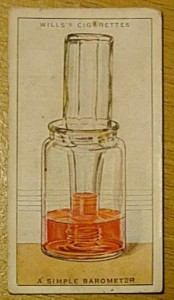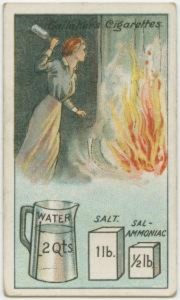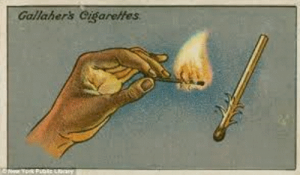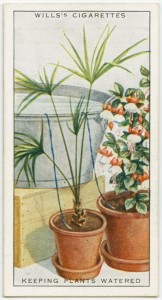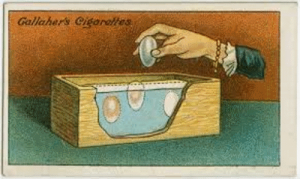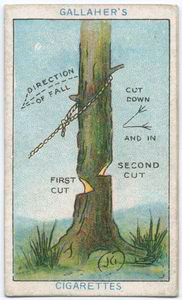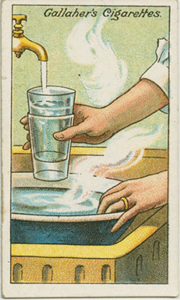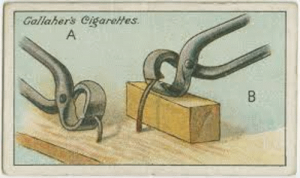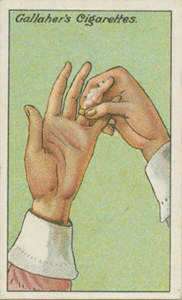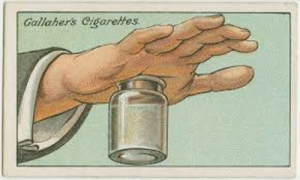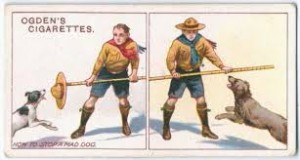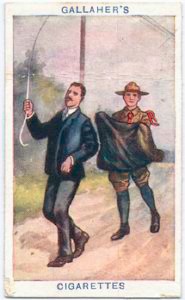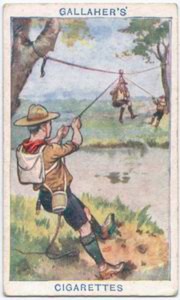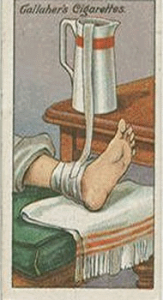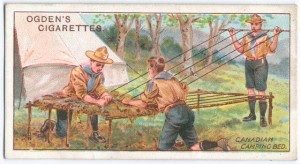When SHTF and today conveniences will no longer be available we will turn back to what our grandfathers use to do to solve different problems. The ”life hacks” below were a way of life for our ancestors and many of these hacks were forgotten or simply not used nowadays.
In the 1910s, Gallaher Ltd of Belfast & London and Ogden’s Branch of the Imperial Tobacco Co printed “How-To” series, with clever hints for both everyday and emergency situations. From steaming out a splinter to stopping a mad dog, these cigarette cards told you the smart way to handle many of life’s problems.
How to make a simple barometer
Here is a simple barometer that a child can make.All that is required is an empty vinegar bottle,an empty glass jam-jar and some water coloured with red ink. Half-fill the bottle with the coloured water and place the jar upside-down over the bottle. Now reverse, so that the jar is standing upright, with the bottle standing in it upside-down. Allow the coloured water to flow into the jar until the level of the water in the bottle is about an inch or two above that in the jar. By the rise and fall of the water in the neck, the weather may be fairly accurately foretold.fine weather will cause it to rise, while a drop may presage rain or rough weather. A ruled card fixed behind the jar enables the rise or fall to be seen more easily.
How to make the perfect boiled eggs
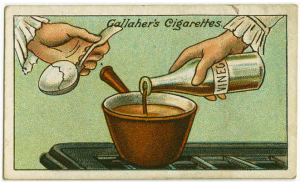 The one and only method I use for perfect hard-boiled eggs and the only one you will use also, this is a no-fail method your eggs will come out perfectly cooked!— don’t omit the vinegar it makes peeling the eggs easier and your eggs will be bright yellow and the whites a pure white! — it doesn’t matter what amount of water or eggs that you use just make certain that you add in about 2 teaspoons of vinegar, I don’t even measure I just pour the vinegar into the water from the bottle the exact 2 teaspoons does not really matter, of course use as many eggs as you wish and the exact amount of ice is not necessary you can use more, also try to use eggs that are at least 2 weeks old fresh eggs are somewhat harder to peel.
The one and only method I use for perfect hard-boiled eggs and the only one you will use also, this is a no-fail method your eggs will come out perfectly cooked!— don’t omit the vinegar it makes peeling the eggs easier and your eggs will be bright yellow and the whites a pure white! — it doesn’t matter what amount of water or eggs that you use just make certain that you add in about 2 teaspoons of vinegar, I don’t even measure I just pour the vinegar into the water from the bottle the exact 2 teaspoons does not really matter, of course use as many eggs as you wish and the exact amount of ice is not necessary you can use more, also try to use eggs that are at least 2 weeks old fresh eggs are somewhat harder to peel.
How to restore a crushed broom
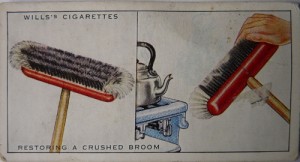 Brooms should never be stood on the bristles, as in time this will result in the bristles getting crushed. If this has
Brooms should never be stood on the bristles, as in time this will result in the bristles getting crushed. If this has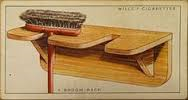 happened they may be restored in the fol-lowing manner. Half fill a kettle with water and bring to the boil. When the steam is pouring steadily from the spout, hold the crushed bristles to it. rub the hand smartly over the brush, taking care, however, not to let it approach too near the scalding steam. This treatment will restore both bristle and fibre brushes. A simply constructed rack for holding brooms is described in this picture.
happened they may be restored in the fol-lowing manner. Half fill a kettle with water and bring to the boil. When the steam is pouring steadily from the spout, hold the crushed bristles to it. rub the hand smartly over the brush, taking care, however, not to let it approach too near the scalding steam. This treatment will restore both bristle and fibre brushes. A simply constructed rack for holding brooms is described in this picture.
How to make a fire extingiusher
“Dissolve one pound of salt and half a pound of sal-ammoniac in two quarts of water and bottle the liquor in thin glass bottles holding about a quart each. Should a fire break out, dash one or more of the bottles into the flames, and any serious outbreak will probably be averted.”
How to light a match in the wind
“The familiar difficulty of lighting a match in a wind can be to a great extent overcome if thin shavings are first cut on the match towards its striking end, as shown in the picture. On lighting the match the curled strips catch fire at once; the flame is stronger and has a better chance.”
How to keep your plants watered while not at home
“Fill a large pail with water, and stand it a little above the level of the plants and group round or near as many plants as practical. Loosely plait two or three strands of wool together, immerse completely in water, and place one end in the pail, weighted, and touching the bottom. Rest the other end on the soil: a separate plait of wool is advisable for each pot.”
How to make a water filter
“A most handy and efficacious filter can be made out of an ordinary perfectly clean zinc water pail, through the bottom of which a hole has been drilled and a small pipe fitted. The water percolates through the layers of fine and coarse sand, and clean picked gravel and stones, with which the pail is filled, filtering through to the bottom in a clear state.”
How to preserve eggs for a longer period of time
“Eggs for preserving must be newly laid, and by simply putting these into a box or tin of dry salt-burying the eggs right in the salt and keeping it in a cool dry place — it is possible to preserve them for a very long period. No air whatever should be allowed to get to the shell.”
How to take down a tree safely
“Having decided which side you wish the tree to fall, cut alternatively a downward and inward cut as shown. When about half through, proceed to cut the other side a few inches higher, and finally pull tree down by means of ropes.”
How to separate glass tumblers
When two glass tumblers stick together there is a danger of breakage in trying to separate them. The simplest and most effective method of releasing the glasses is to put cold water in the upper one and place the lower one in warm water. They will found to separate at once.
How to pull out long nails
It is often rather difficult to pull out a long nail from wood into which it has been driven, for when drawn out a short distance as in A, there is no purchase from which to pull it further. If, however, a small block of wood be placed under the pincers,as in B, the nail can be pulled right out without difficulty.
How to extract a stuck ring from your finger
To remuve a tight ring from the finger without pain or trouble, the finger should be, first well lathered with soap. It will then be found that, unless the joints are swollen the ring can easily be taken off. If , however, the finger and joints are much swollen, a visit to the jeweller is advisable.
How to extract a splinter the easy way
“Fill a wide mouthed bottle with hot water nearly to the brim, and press affected part of hand tightly against mouth of bottle. The suction will pull down the flesh, and steam will soon draw out the splinter.”
How to stop a dog attack
“A scout’s staff, a walking-stick, or even a handkerchief or hat may be held before you as shown. The dog invariably endeavours to paw down your defense before biting, thus giving you the opportunity of disabling him by a kick.”
How to save a person from electric shock
“In rescuing a person touched by a “live wire” do not attempt to take hold of him if he is still grasping the wire, unless your hands are protected by rubber gloves, a water-proof coat, or several thicknesses of dry cloth. Stand on glass or dry wood, and try and have (the) current switched off, and send at once for a doctor.”
How to make a chair to cross a river
“Fasten a strong rope to a tree and let a boy swim across the stream and fasten the other end to a tree on an opposite bank. Make the chair, fasten it to a running loop or a block pulley, and by means of a light rope fastened to the middle of (the) chair and held by a scout at each end, those unable to swim are safely passed over.”
How to treat a sprained ankle
Elevate the injured joint and wrap in cloths wrung out in cold water. The picture shows how to keep the cloths constantly wet without having to change them. Place a jug of water higher than the injured limb and a strip of linen with one end in the jug and the other end resting upon the wrapping of sprained joint. The water will pass from the jug to compress keeping it constantly wet and cold.
How to build a simple shelter
Instructions: “A simple shelter can be made by driving two forked sticks into the ground and connecting these by a pole resting on them. Branches are then laid resting on the pole. The right angle should be around 45 degrees, and the screen fitted up with smaller branches, ferns, etc.”
How to Bandage a Foot

Supporting a sprained ankle with a wrap of some kind helps to prevent a more serious injury from occurring. Wrapping holds the sprained ankle in position so that it heals quickly and correctly. Learn how to wrap an ankle using an ace bandage or athletic tape.Taping with 1 1/2- inch tape is the most common way for athletes to treat their sprained ankles. First an underwrap, a light tape-like cloth, is woven around the affected area, then tape is strategically placed to provide support for the ankle.
How to use a watch as a compass
Align a twig (pointing up) at the edge of your watch so that it casts a shadow onto the face of the watch from the sun.
Then while holding the twig steady, rotate the watch until the twig’s shadow is cast directly onto the position of the hour hand.
In other words, you’re aligning the shadow with the hour hand (you’re pointing the hour hand in the direction of the sun).
Bisect the angle between the hour hand and 12-oclock. This halfway point between the hour hand and the 12-oclock position is your North-South line.
To determine which end of the line is north, remember this…
The sun rises in the east, and is in the east before noon.
The sun is due south at noon.
The sun sets in the west, and is in the west after noon.
Note: If your watch is set to daylight savings time, use the halfway point between the hour hand and 1 o’clock to determine the north-south line.
Want to rediscover more lost knowledge?
Then you really need this amazing book. It is called The Lost Ways and it contains all the knowledge of our  forefathers.
forefathers.
Here’s just a glimpse of what you’ll find in The Lost Ways:
From Ruff Simons, an old west history expert and former deputy, you’ll learn the techniques and methods used by the wise sheriffs from the frontiers to defend an entire village despite being outnumbered and outgunned by gangs of robbers and bandits, and how you can use their wisdom to defend your home against looters when you’ll be surrounded.
Native American ERIK BAINBRIDGE – who took part in the reconstruction of the native village of Kule Loklo in California, will show you how Native Americans build the subterranean roundhouse, an underground house that today will serve you as a storm shelter, a perfectly camouflaged hideout, or a bunker. It can easily shelter three to four families, so how will you feel if, when all hell breaks loose, you’ll be able to call all your loved ones and offer them guidance and shelter? Besides that, the subterranean roundhouse makes an awesome root cellar where you can keep all your food and water reserves year-round.
From Shannon Azares you’ll learn how sailors from the XVII century preserved water in their ships for months on end, even years and how you can use this method to preserve clean water for your family cost-free.
Mike Searson – who is a Firearm and Old West history expert – will show you what to do when there is no more ammo to be had, how people who wandered the West managed to hunt eight deer with six bullets, and why their supply of ammo never ran out. Remember the panic buying in the first half of 2013? That was nothing compared to what’s going to precede the collapse.
From Susan Morrow, an ex-science teacher and chemist, you’ll master “The Art of Poultice.” She says, “If you really explore the ingredients from which our forefathers made poultices, you’ll be totally surprised by the similarities with modern medicines.” Well…how would you feel in a crisis to be the only one from the group knowledgeable about this lost skill? When there are no more antibiotics, people will turn to you to save their ill children’s lives.
And believe it or not, this is not all…
Table Of Contents:
Making Your Own Beverages: Beer to Stronger Stuff
Ginger Beer: Making Soda the Old Fashioned Way
How North American Indians and Early Pioneers Made Pemmican
Spycraft: Military Correspondence During The 1700’s to 1900’s
Wild West Guns for SHTF and a Guide to Rolling Your Own Ammo
How Our Forefathers Built Their Sawmills, Grain Mills,and Stamping Mills
How Our Ancestors Made Herbal Poultice to Heal Their Wounds
What Our Ancestors Were Foraging For? or How to Wildcraft Your Table
How Our Ancestors Navigated Without Using a GPS System
How Our Forefathers Made Knives
How Our Forefathers Made Snow shoes for Survival
How North California Native Americans Built Their Semi-subterranean Roundhouses
Our Ancestors’Guide to Root Cellars
Good Old Fashioned Cooking on an Open Flame
Learning from Our Ancestors How to Preserve Water
Learning from Our Ancestors How to Take Care of Our Hygiene When There Isn’t Anything to Buy
How and Why I Prefer to Make Soap with Modern Ingredients
Temporarily Installing a Wood-Burning Stove during Emergencies
Making Traditional and Survival Bark Bread…….
Trapping in Winter for Beaver and Muskrat Just like Our Forefathers Did
How to Make a Smokehouse and Smoke Fish
Survival Lessons From The Donner Party
Get your paperback copy HERE
CHECK OUR survival and prepping solutions
If you found this article useful, please like our Facebook page and stay up to date with the latest articles.
WHAT TO READ NEXT:
HOW TO MAKE YOUR OWN BACON (STEP BY STEP GUIDE)
A RETURN TO THE OLD PATHS: HOW TO MAKE PEMMICAN LIKE THE NATIVE AMERICANS
20 LOST RECIPES FROM THE PIONEERS: WHAT THEY COOKED ON THEIR JOURNEY WESTWARD
SEVEN CLASSIC GREAT DEPRESSION ERA RECIPES GRANDMA USED TO MAKE
POTTED MEAT: A LOST SKILL OF LONG TERM MEAT STORAGE
BACK TO BASICS: HOW TO MAKE AND PRESERVE LARD
THE BEST WAY TO STOCKPILE VEGETABLES OFF-GRID
OLD FASHIONED PRESERVING-GRANDPA’S RECIPE FOR CURED SMOKED HAM
HOW TO MAKE GUNPOWDER THE OLD FASHIONED WAY
SURVIVAL HERBAL RECIPES FROM OUR ANCESTORS
HOW TO PRESERVE MEAT FOR SURVIVAL LIKE OUR GRANDFATHERS
OTHER USEFUL RESOURCES:
The 3 Pioneer Survival Lessons We Should Learn
The Most Effective Home Defense Strategies
Old School Hacks for Off-Grid Living
The Medical Emergency Crash Course


